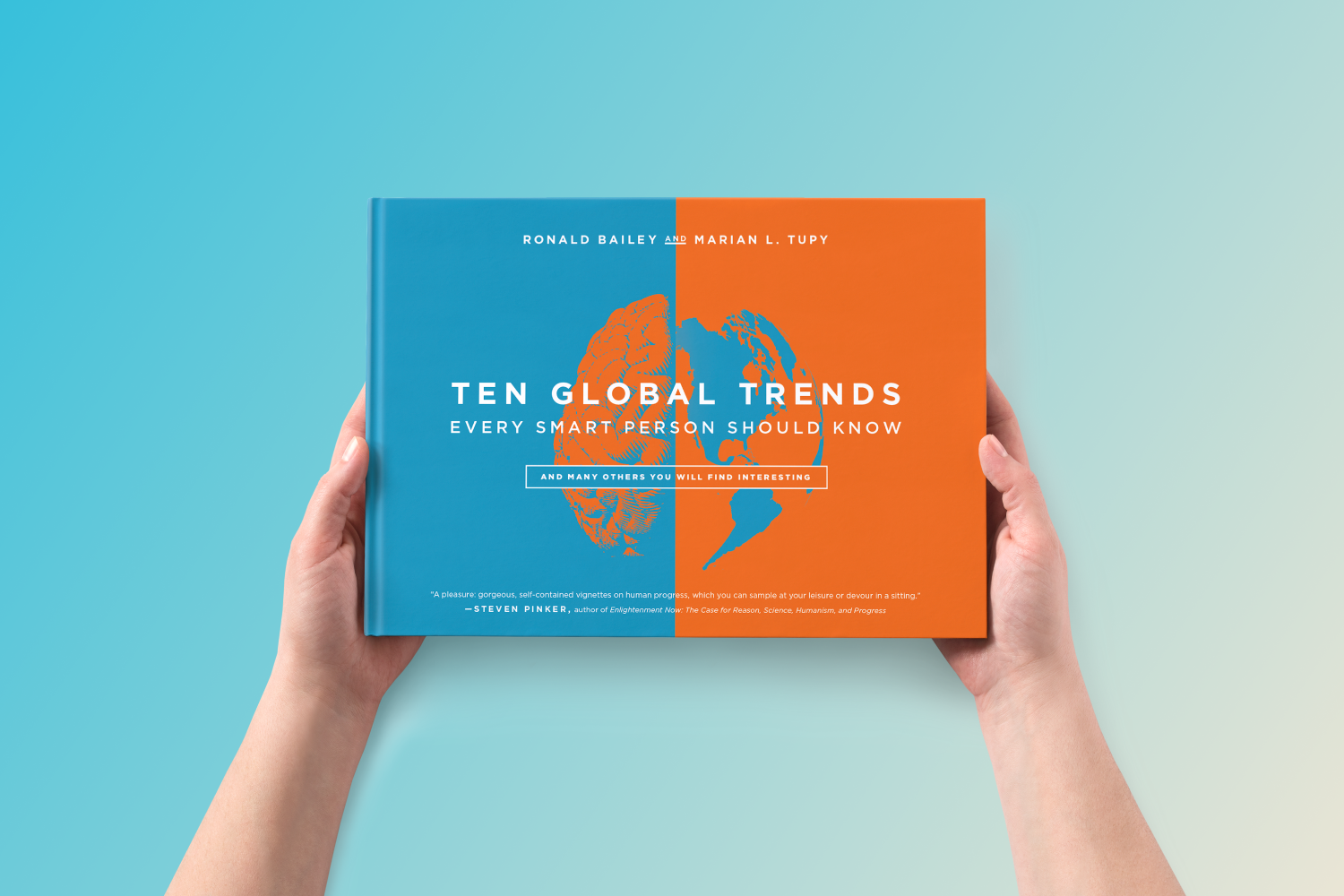Two years ago, Ronald Bailey from Reason magazine made me an offer I could not refuse. Over a business lunch in Washington D.C., Ron proposed that we join forces to write a short book about human progress. He thought for a while about a market opening for an easy-to-read compendium of the most important trends in global wellbeing. I jumped at the opportunity. Ron had six well-received books under his belt already, and I was itching to write my first. Today, our book comes out – later than we intended (more about that below), but we got there in the end.
In Ten Global Trends Every Smart Person Should Know: And Many Others You Will Find Interesting, Ron and I outline 78 improving global and U.S. trends intended to inform readers about the real state of the world. Well-known negativity biases that are deeply entrenched in the human psyche, and which we discuss in the introduction, conspire to make us think of the world as being in much worse shape than it is. So, the primary goal of the book is educational. If readers walk away feeling a sense of pride over the degree and scope of human accomplishment and imbued with a sense of rational optimism about our species’ future, so much the better.
Over the past two centuries, the spread of competitive markets and free trade has contributed to the Great Enrichment. Global average per capita income has steeply risen, and poverty has fallen to its lowest level in all of human history. Human ingenuity and innovation have driven down natural resource prices and boosted food production to record levels. Also, many global environmental trends are improving. The amount of land devoted to agriculture is shrinking, thus sparing land for nature. The proportion of wildlands and oceans set aside for conservation and protection continues to expand.
Topically, we show the continued rise in vaccinations against contagious diseases, and the declining prevalence of HIV/AIDS, malaria, and tuberculosis. We also show that the time from identifying an illness to the invention of new vaccines or life-saving drugs has been growing ever shorter. Thanks to biotechnological progress, it seems likely that a safe and effective vaccine against the COVID-19 virus will be available in less than a year since the outbreak of the pandemic.
Other positive trends that we discuss include the rise in happiness, decline in global income inequality and most forms of violence, a falling share of the world’s population living in slums, political and economic empowerment of women, an uneven but pronounced rise in IQ scores, decriminalization of same-sex relationships, falling cancer death rates, falling rates of military spending and conscription, the shrinkage of nuclear arsenals, reductions in working hours thus leaving more time for leisure, falling rates of child labor and workplace accidents, increasing access to electricity, improving access to sanitation and clean drinking water, and internet-driven access to information.
As noted, the book is light on theory and heavy on graphics – a picture, they say, is worth a thousand words. Straightforward charts are combined with brief explanations to provide readers with easy access to the facts that busy people need to know about the real state of the world. You cannot effectively promote further progress or fix what is wrong in the world if you don’t know what’s actually happening. That’s all the more important now that so much of the planet, including the United States, is gripped by protests and violence. And that brings me to the daunting task of publishing a book like Ten Global Trends in 2020.
I think it is safe to say that this year has not panned out in a way that most of us had hoped or expected. The COVID-19 pandemic has wreaked havoc upon the global economy and taken the lives of hundreds of thousands of people around the world. Millions around the globe are newly unemployed, anxious, depressed, and angry. In many countries, people have taken to the streets to protest many wrongs—some real and some imagined.
“My center is giving way, my right is retreating, excellent situation, I am attacking,” wrote Marshal Ferdinand Foch to the French Commander-in-Chief, Marshal Joseph Joffre, as the German forces advanced on Paris in September 1914. Likewise, Ron and I believe that this a propitious time to launch a counter-attack against the all-engulfing atmosphere of doom and gloom. People, we feel, need a ray of sunshine as we emerge from the COVID-19 lockdowns.
The pandemic outbreak gave us more time to finalize the text and work with two talented Cato Institute designers, Guillermina Sutter Schneider and Luis Ahumada Abrigo, to make our charts as attractive as possible. We are also grateful to Eleanor O’Connor, Jason Kuznicki, and Ian Vasquez (all from Cato) for helping to shepherd the book through the editing and publishing processes.
In conclusion, I hope that you will buy this book and share it with your family and friends. It is meant to be a conversation piece. Instead of gathering dust on a bookshelf, it is designed to lie on a living room table (like so many architecture and interior design books), for visitors to see and discuss over a martini or glass of wine. I hope that it will alleviate some depression and anxiety, spark a fact-filled discussion around the dining room table, and maybe even change some minds. Strangers things have happened. Cheers!

